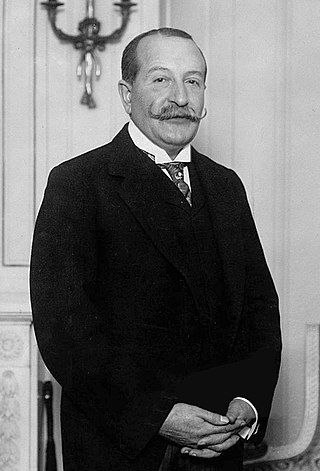
Take or Tache Ionescu was a Romanian centrist politician, journalist, lawyer and diplomat, who also enjoyed reputation as a short story author. Starting his political career as a radical member of the National Liberal Party (PNL), he joined the Conservative Party in 1891, and became noted as a social conservative expressing support for several progressive and nationalist tenets. Ionescu is generally viewed as embodying the rise of middle-class politics inside the early 20th century Kingdom of Romania, and, throughout the period, promoted a project of Balkan alliances while calling for measures to incorporate the Romanian-inhabited Austro-Hungarian regions of Transylvania, Banat and Bukovina. Representing his own faction inside the Conservative Party, he clashed with the group's leadership in 1907–1908, and consequently created and led his own Conservative-Democratic Party.

The Romanian Communist Party was a communist party in Romania. The successor to the pro-Bolshevik wing of the Socialist Party of Romania, it gave an ideological endorsement to a communist revolution that would replace the social system of the Kingdom of Romania. After being outlawed in 1924, the PCR remained a minor and illegal grouping for much of the interwar period and submitted to direct Comintern control. During the 1920s and the 1930s, most of its activists were imprisoned or took refuge in the Soviet Union, which led to the creation of competing factions that sometimes came into open conflict. That did not prevent the party from participating in the political life of the country through various front organizations, most notably the Peasant Workers' Bloc. During the mid-1930s, due to the purges against the Iron Guard, the party was on the road to achieving power, but the dictatorship of king Carol II crushed this. In 1934–1936, PCR reformed itself in the mainland of Romania properly, with foreign observers predicting a possible communist takeover in Romania. The party emerged as a powerful actor on the Romanian political scene in August 1944, when it became involved in the royal coup that toppled the pro-Nazi government of Ion Antonescu. With support from Soviet occupational forces, the PCR pressured King Michael I into abdicating, and it established the Romanian People's Republic in December 1947.

Gheorghe G. Mironescu, commonly known as G. G. Mironescu, was a Romanian politician, member of the National Peasants' Party (PNȚ), who served as Prime Minister of Romania for two terms.
The Conservative Party was between 1880 and 1918 one of Romania's two most important parties, the other one being the Liberal Party. The party was the party of government for a total of 14 years, more than a third of its existence.

Constantin G. Stere or Constantin Sterea was a Romanian writer, jurist, politician, ideologue of the Poporanist trend, and, in March 1906, co-founder of the literary magazine Viața Românească. One of the central figures of the Bessarabian intelligentsia at the time, Stere was a key actor during the Union of Bessarabia with Romania in 1918, and is associated with its legacy.
Grigore Iunian was a Romanian left-wing politician and lawyer. A member of the National Liberal Party (PNL) during the 1910s, he rallied with the Peasants' Party (PȚ) after World War I, and followed it into the National Peasants' Party (PNȚ), before leaving in 1933 to create the Radical Peasants' Party (PȚR), over which he presided until his death.

Constantin C. Arion was a Romanian politician, affiliated with the National Liberal Party, the Conservative Party and, after 1918, the People's Party. He served two terms as Minister of Religion and Public Instruction, one term as Minister of Agriculture, and another one as Interior Minister before World War I. His career peaked in 1918, when he was Minister of Foreign Affairs.

Nicolae Fleva was a Wallachian, later Romanian politician, political journalist and lawyer. Known especially for his involvement in political incidents, and for a stated patriotism bordering on demagogy, he tested all political formulas that Romania's two-party system would allow. His activity in the public sphere brought a decades-long presence in the Assembly of Deputies and a mandate as Mayor of Bucharest between 1884 and 1886.

Nicolae Dimitrie Xenopol was a Romanian politician, diplomat, economist and writer, the younger brother of historian Alexandru Dimitrie Xenopol and, like him, a member of Junimea society. Initially inspired by Junimea leader Titu Maiorescu, he was later a dissident of Junimism, a Positivist and a supporter of literary realism. Politically, Xenopol also moved away from conservatism and was embraced by the liberal current, serving as editor of two liberal newspapers: Românul and Voința Națională. He had a successful career in electoral politics, which began within the National Liberal Party and later saw him joining the Conservative-Democratic Party. In 1912, he was Minister of Commerce, and helped create an Academy of Economic Studies.

Nicolae Filipescu was a Romanian politician.

The People's Party, originally People's League, was an eclectic, essentially populist, mass movement in Romania. Created by World War I hero Alexandru Averescu, it identified itself with the new politics of "Greater Romania" period, and existed for almost as long as Greater Romania did. The PP broke with the antiquated two-party system, creating a wide coalition of lobbies, and advertised itself as the new challenge to the National Liberal Party (PNL). The group was held together by Averescu's charisma, and was popularly known as partidul averescan, "the Averescan party".

The Democratic Nationalist Party or Nationalist Democratic Party was a political party in Romania, established by historian Nicolae Iorga and jurist A. C. Cuza. Its support base was in the lower reaches of the Romanian middle class, and, especially through Cuza's ideology, it reflected the xenophobia, economic antisemitism, and producerism of that particular environment. The PND was a weak challenge to the mainstream political forces, either conservative or liberal, failing in its bid to become Romania's third-strongest party. By 1916, it was effectively split between Iorga's moderates and Cuza's radicals, suspending its activity for the remainder of World War I.

The Vlad Țepeș League, later Conservative Party, was a political party in Romania, founded and presided upon by Grigore Filipescu. A "right-wing conservative" movement, it emerged around Filipescu's Epoca newspaper, and gave political expression to his journalistic quarrels. Primarily, the party supported the return of Prince Carol as King of Romania, rejecting the Romanian Regency regime, and questioning democracy itself. Filipescu stirred public controversy with his critique of democracy, drawing suspicions that he was creating a localized fascism. In its original form, the LVȚ idealized efficient government by dictatorial means, and allowed its fringes to be joined by ultra-nationalists and fascists. One of these was the youth-wing organizer, Gheorghe Beza, expelled from the group in 1930, after his assassination attempt on minister Constantin Angelescu.

Grigore N. Filipescu was a Romanian politician, journalist and engineer, the chief editor of Epoca daily between 1918 and 1938. He was the scion of an aristocratic conservative family, son of the statesman Nicolae Filipescu and a collateral descendant of Alexandru II Ghica. During the early stages of World War I, he and his father led a pro-Allied dissident wing of the Conservative Party. After serving on the front, and behind the lines to 1918, as aide to General Alexandru Averescu, Filipescu Jr. became his political adviser. He had a stint in the Labor Party, merged into Averescu's own People's Party. Filipescu served as the latter group's tactician and campaigner, but had irreconcilable differences with Averescu.

General elections were held in the Kingdom of Romania from March 1 to March 14, 1911, confirming a majority for the Conservative Party (PC) under Petre P. Carp. The united opposition was constituted of the National Liberal (PNL) and Conservative-Democratic (PCD) parties, with Ion I. C. Brătianu and Take Ionescu as the leaders. The PCD, founded in 1908 from a middle-class Conservative splinter group, was making its first appearance nationally. A quickly rising third-party, its alliance with the PNL helped the latter survive and consolidate. The elections were also contested by two other new political actors: the right-wing Democratic Nationalist Party, and the left-wing Social Democratic Party. Both failed to win any seats.

The Free and Independent Faction or Free and Independent Fraction was a nationalist and national liberal party in Romania, regionally centered on Western Moldavia. Originally informal, and defined by its adversaries, the Faction mainly comprised pupils and followers of the philosopher Simion Bărnuțiu. During most of its existence, it had as its recognized leader the academic and polemicist Nicolae Ionescu.

Elections for the ad hoc Divan were held in Wallachia in September 1857. They restored a liberalizing trend that had been repressed following the 1848 revolution, also giving expression to the national awakening that was taking part among the Romanians. The toppling of the conservative Regulamentul Organic regime in both Danubian Principalities made them possible: following the 1856 Treaty of Paris, Wallachia and Moldavia functioned as a protectorates of the European powers; both were also clients of the Ottoman Empire. Excluding the spontaneous rallies of 1848, this was the first public consultation to be held in eleven years. It ran in conjunction with the Moldavian Divan elections, and, like them, had unusually lax criteria for participation, allowing peasants and guilds to vote by indirect suffrage.
Ion Cămărășescu was a Romanian politician.

The first cabinet of Titu Maiorescu was the government of Romania from 14 October 1912 to 31 December 1913.





















